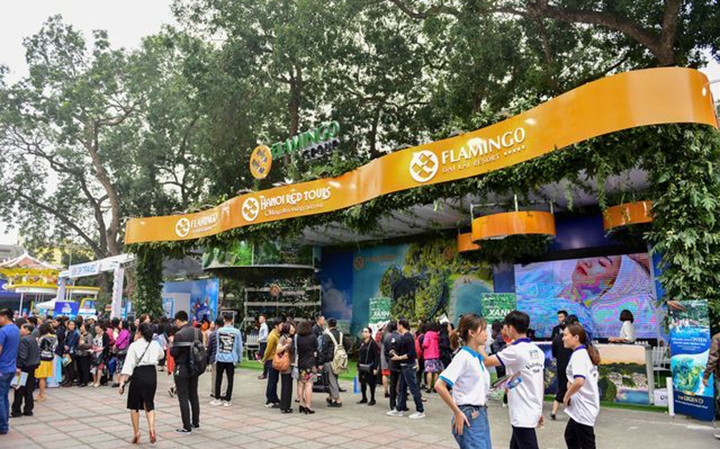As a leading attractive destination in the region, Viet Nam has seen spectacular and strong growths in tourism and defined green tourism as a ‘key’ for the sector’s sustainable development.

Green pavilions at the recent VITM in Ha Noi.
According to the Institute for Tourism Development Research, green tourism is known as tourism development based on the rational and efficient exploitation of natural resources, in association with environmental protection, biodiversity conservation, the reduction of greenhouse gas emissions and climate change adaptation.
In recent years, green tourism has become the trend of this ‘smokeless industry’ in many countries worldwide because of its great role in biodiversity protection and community culture, as well as its contribution to socio-economic development. In addition, research from Trip Advisor showed that 34% of tourists are willing to pay more for environmentally friendly hotels, while 50% of international visitors are willing to pay more for companies that can provide benefits to the local community and conservation activities.
Accordingly, green tourism is not only a guarantee for the sustainable development of tourism but also a solution to increase the number of tourists with high spending levels and civilised actions.
Owning diverse natural resources and culture - humanities, Viet Nam has many favourable conditions to develop green tourism. Under the Strategy for Vietnamese tourism development by 2020, with a vision to 2030, the development of green tourism products, in line with respecting natural elements and local culture, is a measurement for sustainable tourism development in the country.
However, the fact of exploiting tourism activities over the past few years has shown that this direction has faced numerous challenges that were discussed at a forum on green tourism under the 2019 Viet Nam International Travel Mart (VITM) in Ha Noi.
The first challenge is the limitation in the awareness of green tourism development from organisations, enterprises and individuals participating in investment and development activities. Prof. Dr. Nguyen Van Diem, Chairman of the Council of Science and Education under the Viet Nam Tourism Association, frankly pointed out several negative issues, including the appearance of untreated solid waste, garbage and wastewater in many tourist areas and the risk of coastal erosion due to the unplanned construction of accommodation establishments and tourism services. The conflict of economic interests, short-term vision and low development of technology has also led several natural resources to be devastated and misused, adversely affecting the image and sustainable development of Vietnamese tourism.
According to Dr. Nguyen Anh tuan, Director of the Institute of Tourism Research and Development, one barrier for green tourism is also the lack of mechanisms, policies, and specific guidelines for the development of this type of tourism. The national strategy on green tourism was approved by the Government in 2012, however, synchronous mechanisms and policies to promote the development of green tourism or detailed regulations have not been issued. In addition, the requirement of a large amount of money for initial investment for green solutions is also a difficulty that causes enterprises and localities to hesitate.
In order to realise the goals of green tourism, the basic measure is to raise awareness of green tourism for managers at all levels, corporate executives, tourism makers and visitors. Dr. Nguyen Van Dinh also noted that it is crucial to plan specific actions in construction, organisation, planning management, assessment and the implementation of investment projects to develop tourism products at all levels, in order to create favourable condition for green tourism. On the other hand, the State should issue essential policies to enhance green solutions in developing tourism technical facilities in line with specific conditions in each locality, such as the application of natural energy, the use of friendly materials and waste and wastewater processing and treatment. In addition, it is essential to encourage programmes on preserving and promoting folk culture in tourism as well as issue a set of criteria for green tourism so that management agencies and travel enterprises can utilise them during their investment, planning and business activities.
Over the past few years, several travel companies have actively applied many measures to promote green development with electricity and water saving models as well as developing responsible tours such as discovering caves in Phong Nha – Ke Bang (Quang Binh province) and scavenging in Hoi An ancient city in Quang Nam province.
Themed ‘Green Tourism’, the recent VITM also promoted and affirmed the leading role of enterprises. Many companies showed their determination to achieve green growth right through their pavilions designed with environmentally friendly materials as well as tours towards encouraging visitors to raise their awareness of environmental protection.
The remarkable change in awareness and active spirit of many travel businesses, along with the attention and appreciation from the State to the importance of green tourism will be premises for the sustainable and green growth of the ‘smokeless industry’ of Viet Nam in the near future.